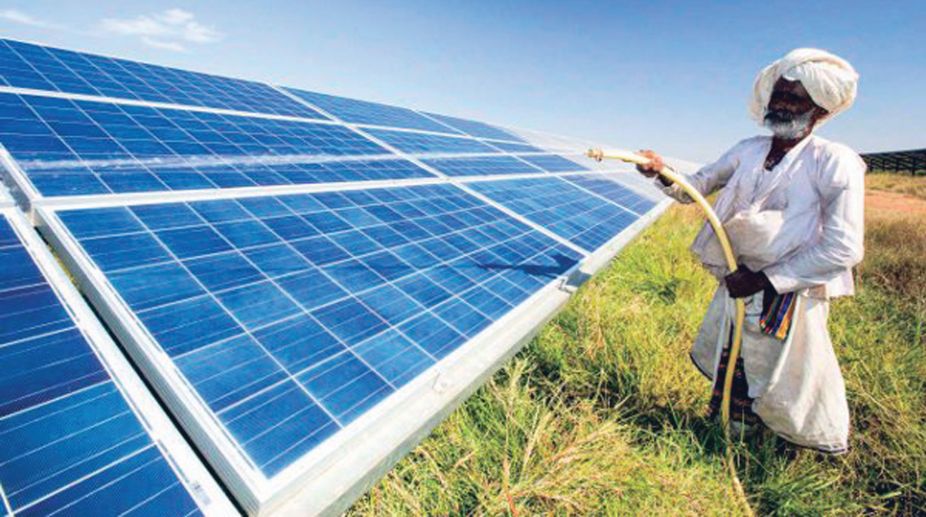India is blessed with 300 days of sunshine in a year and is making long strides towards becoming a solar superpower. The National Solar Mission was launched in 2010 with an ambitious target of deploying 20 GW of grid connected solar power by 2022. Solar is one of the eight missions of the 2008 National Action Plan on Climate Change. But the target was changed to 100 GW by Prime Minister Narendra Modi in 2015. Out of 100 GW, 40 GW is targeted to come through rooftop solar installations by 2022.
Finding open spaces to install solar parks in Indian cities is difficult. Rooftop solar installations can be installed on the roofs of buildings. Rooftop[AR1] solar benefits the environment. The most important benefit is that rooftop solar installations can provide electricity to areas not connected to the grid, such as remote locations or where the terrain makes it difficult to install power stations.
India has a total installed solar capacity of 1861 MW as of September 2017. Thus, there is a huge gap between the currently installed and expected capacity by 2022. Considerable efforts have been made by regulatory commissions, agencies and the government to develop the rooftop solar photovoltaic (PV) sector.
To accelerate the deployment of rooftop solar power in the country, the Ministry of New and Renewable Energy (MNRE) has proposed to bring distribution utilities/companies (DISCOMs) to the forefront in implementing the Grid Connected Rooftop Solar (RTS) Power Programme by providing them financial support. Such support will be linked to their performance in facilitating the deployment of RTS.
MNRE hopes to install increasing amounts of rooftop PV annually, growing from 5000 MW in 2017, 6000 MW in 2018, 7000 MW in 2019, 8000 MW in 2020 and 9000 MW in 2021. In December 2015, the central government approved the central financial assistance (CFA) for implementing ‘Grid Connected Rooftop and Small Solar Power Plants Programme’. CFA meets up to 30 per cent of the benchmark cost/tender cost (whichever is lower).
Under the programme, only residential, institutional and social sectors are eligible for CFA. As of January 2018, 2047 MWp (Mega Watt peak, a solar power measure in the photo-voltaic (PV) industry to describe a unit’s nominal power) rooftop capacity plants have been sanctioned under the programme and about 845 MWp rooftop capacity plants have been installed.
MNRE has identified the major issues for slow progress of installing rooftop solar systems. DISCOMs have been reluctant to participate because of revenue loss, lack of state policies and lack of uniform regulation. To addresses these issues, MNRE proposes that DISCOMs be made solely responsible for implementing the rooftop solar programme. DISCOMs will provide approval for installation, manage the distribution network and have billing interface with the rooftop owner.
Since DISCOMs already have direct access to their customers, MNRE hopes that RTS client acquisition cost would be reduced substantially. An incentive scheme has been suggested since DISCOMs would have to incur some additional spending in implementing the programme.
MNRE proposes to bring DISCOMs to the forefront in RTS implementation by providing them performance-based fiscal support. The incentives may be provided for each MWp capacity of solar rooftop that is added by them in their distribution network. It is also proposed that CFA will be provided only for installation of RTS plants in residential sectors.
DISCOMs will submit cumulative capacity of grid connected RTS plants (in MWp) installed in their jurisdictional area as of 31 March 2018. This number will be taken as the installed base capacity for the first year. The incentives will be given on incremental RTS capacity installed by the DISCOMs.
The proposed target for the commercial and industrial sector is 20000 MW. The target for the government, residential, institutional and social sectors are 50000 MW each.
Central Financial Assistance for residential installation of 5KW or less is Rs. 18000/kW calculated at benchmark cost of Rs. 60000/kW. For all other sectors the rate is Rs. 5500/kW. The benchmark cost of the PV system includes PV modules, inverters, minimum storage batteries, cost of meters, cost of civil works, foundations, installations, operation and maintenance for a period of five years.
The scheme would be in operation until March 2022.






